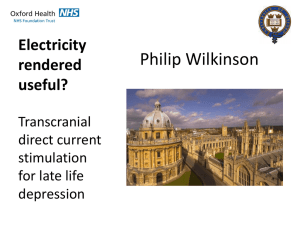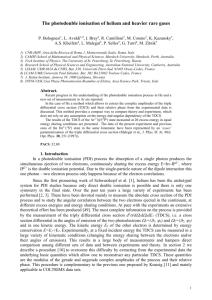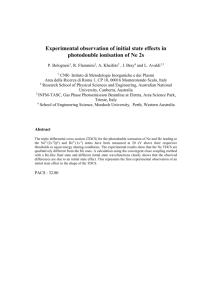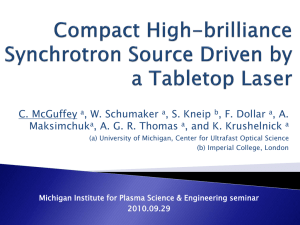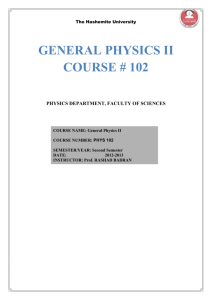BFK07
advertisement
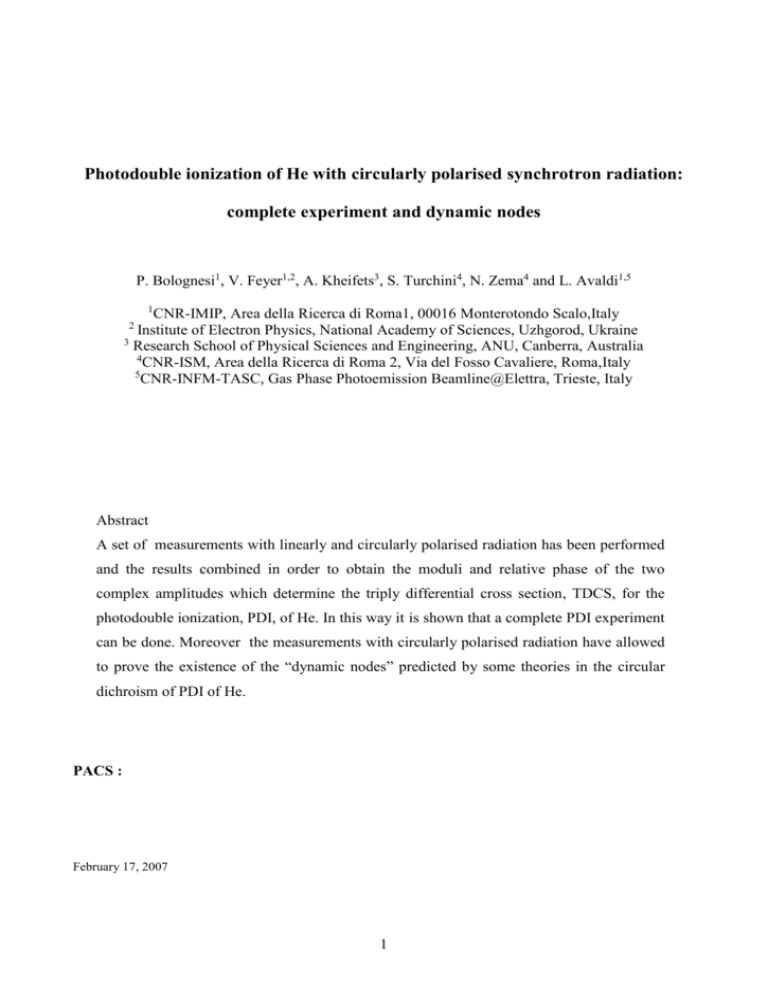
Photodouble ionization of He with circularly polarised synchrotron radiation: complete experiment and dynamic nodes P. Bolognesi1, V. Feyer1,2, A. Kheifets3, S. Turchini4, N. Zema4 and L. Avaldi1,5 1 CNR-IMIP, Area della Ricerca di Roma1, 00016 Monterotondo Scalo,Italy Institute of Electron Physics, National Academy of Sciences, Uzhgorod, Ukraine 3 Research School of Physical Sciences and Engineering, ANU, Canberra, Australia 4 CNR-ISM, Area della Ricerca di Roma 2, Via del Fosso Cavaliere, Roma,Italy 5 CNR-INFM-TASC, Gas Phase Photoemission Beamline@Elettra, Trieste, Italy 2 Abstract A set of measurements with linearly and circularly polarised radiation has been performed and the results combined in order to obtain the moduli and relative phase of the two complex amplitudes which determine the triply differential cross section, TDCS, for the photodouble ionization, PDI, of He. In this way it is shown that a complete PDI experiment can be done. Moreover the measurements with circularly polarised radiation have allowed to prove the existence of the “dynamic nodes” predicted by some theories in the circular dichroism of PDI of He. PACS : February 17, 2007 1 The understanding of the correlated motion of electron pairs plays a key role in the knowledge of the structure and properties of matter and is of fundamental interest in a number of branches of physics [1]. Photodouble ionization, PDI, of He represents the simplest process where the role of the electron correlations can be studied in detail and in the last ten years a lot of experimental and theoretical interest has been paid to this process [2-4]. The most suited way to study PDI is an experiment where either the two photoelectrons or a photoelectron and the recoiling ion are detected in coincidence. In these experiments the triple differential cross section, d3σ/dΩ1dΩ2dE1 (TDCS) is measured. Ω1=(1,φ1) and Ω2=(2,φ2) are the angles of emission of the two electrons and E1 is the energy of one of them. The energy of the second electron is determined by energy conservation hv-IP2+= E1+E2 where hv is the photon energy and IP2+ is the double ionization potential. By considering the 1Po symmetry of the electron pair continuum wavefunction and the invariance by rotation around a preferential symmetry axis, the TDCS can be written in a way that allows the full separation of the geometrical factors and the dynamic parameters [2,4]. While the geometrical factors come from the description of the interaction of the photon with the target in the dipole approximation, the dynamic terms include all the physical information on the dynamics of the process, i.e. the effects of the electron-electron and electron-residual ion interactions. This information is provided by two complex amplitudes ag(E1,E2, 12) and au(E1,E2, 12) [5], which are respectively symmetric (gerade) and antisymmetric (ungerade) with respect to the exchange of the two electrons. These are the basic quantities that can be calculated by the theories and then used to reconstruct any particular TDCS. Thus the extraction of the moduli and relative phase, , of the gerade and ungerade complex amplitudes from the experimental data at a fixed incident energy and energy sharing between the electrons is of considerable interest, because it allows a direct comparison among different sets of data and between theory and experiment. After some attempts relying upon parametrization of ag and au with various degree of complexity and approximation [6,7], Bolognesi et al. [8] proposed a procedure that i) does not rely on any approximation, ii) needs only few determinations of the TDCS at the same relative angle 12 between the photoelectrons and iii) can be applied to any set of experimental data. Up to now the method has been applied only to measurements with linearly polarized incident radiation. In such a case the |ag|2, |au|2 and cos are obtained by solving a set of three non-linear equations. However the sign of the phase remains undetermined. If two sets of measurements obtained at the same photon energy and energy sharing, but with linearly and circularly polarized radiation are combined then also the sign of can be determined and the complete description of the PDI process achieved. Indeed when the incident radiation is circularly polarized the He TDCS displays an helicity dependence, i.e. a non vanishing circular dichroism, 2 CD, can be measured [9,10]. The observation of chirality in a pair of electrons ejected by a target with a spherically symmetric ground state(1Se), like the He atom, might surprise. Indeed in a common wisdom chirality is a property associated to objects which are not identical to their mirror image. However Berakdar and Klar [9,11] have shown that the helicity of the incident photon is transferred to the three body-system, the He atom, and the continuum spectrum of this excited system depends on the helicity of the absorbed photon. This can be seen as a manifestation of the parity conservation [11]. In the initial state the system made by the atom and the photon has a certain parity, carried by the photon. In the final state, after the photon absorption, this parity state is carried by the two electrons, which form a “chiral pair”. The conditions to observe a non vanishing CD are : i) the two electrons unevenly share the excess energy; ii) the direction of the incident light and the directions of the two ejected electrons are not lying in one plane. CD is proportional to sin , thus the combination of the CD measurement and the TDCS measured with linearly polarized radiation provides the full set of information for a complete experiment. A few measurements of the CD are available at 9, 20 and 60 eV above the IP 2+[12-16]. However these have never been coupled with measurements with linearly polarised radiation in order to achieve a complete experiment. Moreover a specific aspect predicted by theory of PDI with circular polarised radiation have not yet been investigated in detail. This is the existence of ‘dynamic nodes’ of the CD, occurring whenever the ungerade and gerade amplitudes of the TDCS have a phase difference δ = 0 or π [10]. They have been predicted to occur at certain values of E1+E2, R=E1/E2 and relative angle 12 by calculations based on the 3C theory [10]. This finding has been supported by later calculations in the framework of the Convergent Close Coupling, CCC, model [17] and recently by the lowest-order perturbative approach, LOPT, of Istomin et al [18]. Other theories [16] predict no such nodes. As for the experiments some evidences have been provided [12,15], but nobody performed the most direct experiment to check the theoretical predictions. This involves a measurement of the CD at fixed 12 (12≠ 0 or 180°, which would make CD=0 always) and E1 as a function of hv and, of course, of E2, which has to be scanned simultaneously with hv. In such a measurement the “existence” of a dynamic node is directly verified by the observation of a change in the sign of the measured CD. The goal of this work is twofold. It aims to combine two sets of measurements with linearly and circularly polarised radiation in order to achieve a complete PDI experiments determining the moduli and relative phase of ag(E1,E2, 12) and au(E1,E2, 12), and then to investigate the existence of the “dynamic nodes”. 3 The experiments have been performed using the electron-electron multicoincidence endstation [19] at the Gas Phase Photoemission [20] and Circularly Polarised [21] beamlines of the Elettra storage ring. Two independently rotatable turntables are housed in the chamber. Seven spectrometers are mounted at 30 angular intervals on a turntable that rotates in the plane perpendicular to the direction, z, of propagation of the incident radiation, while three other spectrometers are mounted at 0, 30 and 60 with respect to polarisation vector =x of the light on a smaller turntable. This turntable can be rotated from the perpendicular plane to the (z,x) plane. In these measurements both the arrays have been kept in the perpendicular plane. The three fixed analyzers have been set to detect electrons of kinetic energy E1=3.5 eV, while the other seven were set to detect electrons with a variable kinetic energy E2 from 20 to 50 eV depending on the type of measurements performed. The energy resolution and the angular acceptance in the dispersion plane of the spectrometers were E/E1,2=0.03 and 3, respectively. The relative angular efficiency of the analyzers have been established by measuring photoelectron angular distributions with well known asymmetry parameters. The light source of the Gas Phase Photoemission beamline is an undulator of period 12.5 cm, 4.5 m long. The experiment has been performed at h=127 eV, using the first harmonic of the undulator. The odd harmonics of the radiation emitted by the undulator are expected to be completely linearly polarized. This has been checked by measuring the photoelectron angular distribution of He+ (n=2) at the same photon value. The light source of the Circularly Polarised beamline is an electromagnetic undulator [21]. From the measurement of the photoelectron angular distribution of the He+(n=2) satellite states we determined that at hv=68.5 eV the radiation emitted by the electromagnetic undulator is not fully circularly polarized, but it is characterized by the Stoke parameters S1=0.31, S3=±0.95 and the major axis of the polarization ellipse lays at λ=35° with respect to the orbital plane of the electrons in the ring. Here we adopted the definition (convention) that S3=1 corresponds to a radiation whose polarization vector rotates counterclockwise for an observer looking towards the source. According to the theoretical argument that the degree of circular polarization at the first harmonic is independent of the undulator settings that determine its energy position [22], we have assumed these values for all the measurements performed in this work (102.5≤hv ≤142.5 eV). In the case of an incident radiation that propagates along the z axis and is linearly polarised along the x axis the TDCS, according the parametrisation which takes into account the invariance with respect to the rotation around a preferential symmetry axis , first proposed by Huetz et al. [5], can be written 4 TDCS ( E1 , E2 , 12 ) ag E1 , E2 , 12 cos 1 cos 2 au E1 , E2 , 12 cos 1 cos 2 2 ag cos 1 cos 2 au cos 1 cos 2 2 Re( ag au* ) cos 12 cos 22 2 2 2 2 ag cos 1 cos 2 au cos 1 cos 2 2 ag au cos cos 12 cos 22 2 2 2 2 (1) where 1 and 2 are the angles of emission of the two photoelectrons with respect to and 12 is the relative angle between the directions of emission of the two photoelectrons. In the more general case of an elliptically polarized radiation the TDCS in the perpendicular plane with respect to the direction of the incident radiation can be again expressed as a function of the complex amplitudes 2 TDCS ( E1 , E 2 , 12 ) a g (1 cos 12 ) au (1 cos 12 ) 2 2 S1 cos( 21 cos 12 ) a g (1 cos 12 ) au (1 cos 12 ) 2 sin( 21 cos 12 ) sin 12 Re( a g au* ) 2 2S 3 sin 12 Im( a g au* ) where 1 is now referred to the major axis of the polarization ellispse. In the case of fully circularly polarised radiation ( S3=±1, S1=0) the TDCS is independent of 1. Thus the TDCS measured at the same 12, but different 1 can be added up. The main effect when using elliptically polarised radiation is a variation of the ratio of the two lobes of the TDCS measured at different 1. This has been observed for instance in the measurements by Collins et al [16], where 1 was varied over more than 100°. Here 1 varies ±30° with respect to the direction of the major axis of the polarization ellipse. A simulation of the TDCS in the conditions of our experiment using f.la(2) and the amplitudes predicted by the CCC model showed variations of TDCS comparable or less than the uncertainty associated with the measurements. Therefore we added up the data at the same 12 of the three TDCS, simultaneously measured in the experiment . The circular dichroism, CD, is obtained by measuring the TDCS with left- and right-circularlypolarised radiation and is given by CD( E1 , E 2 , 12 ) 1 TDCS L ( E1 , E 2 ,12 ) TDCS R ( E1 , E 2 ,12 ) S3 4S 3 sin 12 Im( a g au* ) 4S 3 sin 12 a g au sin 3 From the experimental point of view it is also convenient to define the normalized circular dichroism, CDn, defined as 5 2 CDn ( E1 , E2 ,12 ) 1 TDCS L ( E1 , E2 ,12 ) TDCS R ( E1 , E2 ,12 ) S 3 TDCS L ( E1 , E2 ,12 ) TDCS R ( E1 , E2 ,12 ) (4) Formulas (1-4) show that a proper set of measurements of the TDCS with linearly and circularly polarized radiation can provide the full information on the complex amplitudes, i.e. their moduli and relative phase . In panels (a-c) of figure 1 the three TDCS measured simultaneously at 127 eV for E1=3.5 eV and 1=0,30 and 60 ° with linearly polarized radiation are shown. In panel (d) the CDn measured at the same photon energy and energy sharing is displayed. In panels (a-c) also the polar plots of the TDCS, which allow to evaluate the variation in shape versus 1, are shown. In the panel (d) the TDCS measured with the two helicities of the radiation used to extract the CDn are also shown. All the experimental data have been compared with the prediction of the CCC model [ 17]. The CCC method is a fully numerical approach that relies on heavy computations. For the final state, it solves the Schrödinger equation for the system of a photoelectron scattering on a singly charged ion by employing the close coupling expansion of the total two-electron wave function. In the CCC method, the PDI results from the electron impact ionisation of the singly charged He+ ion. In He, the initial state is represented by a highly correlated Hylleraas type wave function, the use of which ensures that the results have insignificant dependence on the gauge of the electromagnetic interaction. The He CCC integrated PDI cross sections and TDCS agree with experimental ones over a broad energy range. An excellent agreement between theoretical predictions and experiments have been observed in all the studied case. The three TDCS measured with linearly polarized radiation are on the same relative scale, because they have been measured simultaneously. In the comparison with the theory they have been arbitrarily rescaled by a common factor. Thus in this case CCC correctly predicts not only the shape of the TDCS, but also the relative intensity versus 1. The quality of the experimental data in the case of the TDCS measured with circularly polarized radiation is worse than in the case of the measurements with linearly polarized radiation. However a reasonable agreement within the experimental uncertainties is observed between theory and experiment in both the TDCS and CDn. The procedure proposed by Bolognesi et al [8] has been applied to the data of the three TDCS measured with linearly polarized radiation . The method is based on three independent determinations of the TDCS at the same E1,E2 and 12. These values are inserted in a non-linear system of three equations based on f.la(1) , whose solution gives a set of |ag|2, |au|2 and cos δ. These quantities have been used then to reproduce the measured CDn. This provides us with the sign of the relative phase δ, too. The results of the procedure are shown in figure 2, where they are also compared with the CCC theoretical predictions. 6 Due to the geometrical constraints of our set-up we can obtain the amplitudes and phase only in the region 12 >90°, because with the three analyzers of the smaller turntable fixed at 0,30 and 60° we can’t get three independent determinations of the TDCS at 12 <90°. The moduli of the amplitudes in the region investigated are well represented by Gaussian functions. This finding is in agreement with the results by Kheifets and Bray [23] who theoretically verified that Gaussian approximation for the gerade and ungerade amplitude of the TDCS holds up to an excess energy of 60 eV. The width of the gerade amplitude (g=98.7±2.9°) appears to be bigger of the ungerade one (u =73.7±3.8°). These values agree very well with the analysis of previous measurements performed at 40 eV [7,24] and 60 eV [25] energy above the PDI threshold. The agreement with the theoretical predictions is excellent also in the case of the phase. It is interesting to note that at about 12=85° the CDn crosses zero and changes sign (fig.1d). This is due neither to a vanishing value of the amplitudes nor to the geometrical factor in f.la(3). Thus it must be due to a zero in the sinδ. Indeed in figure 2c the theory predicts δ=π at this 12. Therefore this corresponds to a clear observation of a “dynamic node”. In a recent work Istomin et al. [18] discussed the origin of the dynamic nodes within the frame of their LOPT model. Their analysis of the CD versus 12 resulted in the predictions that “at all excess energies up to 50 eV” two dynamic nodes should be observed: one in the range 14.6°≤12≤40.1° and the other in the range 81.3°≤12≤88.4°. The present observation confirms the prediction of a node in the range of the larger 12. No experimental data cover the range of the smaller 12, however the present calculations don’t appear to support the prediction of a node in that region. In order to investigate better the existence of dynamic nodes a second set of measurements has been done between 102.5 and 142.5 eV. The energy E1 of the slow electron was always kept fixed at 3.5 eV, while the energy E2 of the fast electron was incremented according to the variation of the photon energy. In figure 3a the CDn measured at six different energies are reported versus the relative angle 12. A change in sign of the measured CDn, from 12=67°, where within the experimental uncertainties the values at all the energies are positive, to 12=120°, where all the measured values are negative, is clearly observed. To better display this result the measured CDn at 12=67, 97 and 127° are reported as a function of E2 in figure 3b. Consistently with the predictions of the CCC model the CDn is changing sign at 12=97° when E1=3.5 eV and E2=35 eV. This result definitely proves the existence of the “dynamic nodes”, whose occurrence depends on the energy sharing and relative angle 12 between the two electrons, as firstly predicted by Berakdar et al [10]. The realization of complete experiments, where all the basic quantities, i.e. the amplitudes of the matrix elements of a particular process, are measured, is one of the main goal in atomic physics. 7 Indeed the knowledge of these elements allows to predict all the other observables of the process and represents the ultimate test of any theoretical description. Electron-electron and electron-ion coincidence experiments have been proved to be one the most suited tool in the realization of complete photoionization experiments, as shown by the photoelectron-Auger electron experiments in the case of the atomic photoionization [26,27] and by the photoelectron-ion experiments in the case of the molecular inner shell photoionization. [ 28 ]. Here we have shown that only the combination of a series of electron-electron coincidence experiments with linearly and circularly polarized radiation enabled us to achieve a unique determination of the amplitudes needed to achieve a complete quantomechanical description of the PDI in He. A second main result of this work is the experimental verification of another facet of PDI with circularly polarised radiation. This corresponds to a node in the CD in a condition where the relative phase between the two amplitudes which govern the process is 0 or π. Akcnowledgments Work partially supported by the INTAS Research Project ‘Dynamics of correlated particles in the continuum’, No 0-51-4706, the MIUR FIRB project ‘Probing the microscopic dynamics of chemical reactivity’. V. Feyer thanks the ICTP for a TRIL scholarship. A.K. thanks the Short Term Mobility program of CNR . 8 Figure captions Figure 1 : He TDCS for E1=3.5 eV, E2=44.5 eV and 1=0° (a), 30 (b) and 60°(c). E1=35 eV and E2=5 eV (b). In the top-left corner of each panel the experimental data are reported also in polar plots. In panel (d) the CDn versus12 is shown. In the top-right and bottom-left corner of the same panel the TDCS obtained with the two helicities of the radiation are reported. The experimental TDCS are compared with the predictions of the CCC model (solid line). Figure 2 : ag2, au2 and obtained from the experimental TDCS and the CDn shown in figure 1 compared with the predictions of the CCC (full line). Figure 3 : CDn versus 12 at E1=3.5 eV and six different 20.5≤E2≤59.5 eV (a) and versus E2 at 12=67° (dots), 97° (triangle) and 127°(diamond) (b). The solid lines in (b) are the CCC predictions. 9 60 (a) 40 coincidence yield (arbitrary units) 20 0 0 60 120 180 240 300 360 2(degree) 60 (b) 40 20 0 0 60 120 180 240 300 360 2 (degree) 60 (c) 40 20 0 0 60 120 180 240 300 360 2 (degree) 1.2 (d) 0.8 CDn 0.4 0.0 -0.4 -0.8 -1.2 0 60 120 12(degree) Figure 1 10 180 200 |ag| 2 150 100 50 0 60 120 180 12(degree) 15 |au| 2 10 5 0 60 120 180 12(degree) 240 180 120 60 60 120 degree Figure 2 11 180 1.0 (a) E2= 20.5 eV 29.5 eV 39.5 eV 44.5 eV 49.5 eV 59.5 eV CDn 0.5 0.0 -0.5 -1.0 60 80 100 120 140 160 180 12 (deg) 0.6 (b) 0.4 12=67° CDn 0.2 0.0 97° -0.2 -0.4 127° -0.6 20 30 40 50 60 E2(eV) Figure 3 12 70 References [1] P. Fulde, “Electron correlations in moleculs and solids”, Spring Verlag, Berlin 1991 [2] J. S. Briggs and V. Schmidt, J. Phys. B: At. Mol. Opt. Phys. 33, R1 (2000 ) [3] G. C. King and L. Avaldi, J. Phys. B: At. Mol. Opt. Phys. 33, R215 (2000) [4] L. Avaldi and A. Huetz, J. Phys. B: At. Mol. Opt. Phys. 38, S861 (2005) [5] A. Huetz, P . Selles, D. Waymel and J. Mazeau, J. Phys. B:At. Mol. Opt. Phys. 24, 1917 (1991) [6] L. Malegat, P. Selles and H. Huetz, J. Phys. B: At. Mol. Opt. Phys. 30, 251 (1997) [7] S. Cvejanovic and T. Reddish J. Phys. B: At. Mol. Opt. Phys. 33, 4691 (2000) [8] P. Bolognesi et al, J. Phys. B: At. Mol. Opt. Phys. 36, L241 (2003) [9] J. Berakdar and H. Klar, Phys. Rev. Lett. 69, 1175 (1992) [10] J. Berakdar, H. Klar, A. Huetz and P. Selles, J. Phys. B: At. Mol. Opt. Phys. 26, 1463 (1993) [11] J. Berakdar and H. Klar, Phys. Rep. 340, 473 (2001) [12] J. Viefhaus et al, Phys. Rev. Lett. 77, 3975 (1996) [13] V. Mergel et al, Phys. Rev. Lett. 80, 5301 (1998) [14] K. Soejima, A. Danjo, K. Okuno and A. Yagishita, Phys. Rev. Lett. 83, 1546 (1999) [15] M. Achler et al, J. Phys. B: At. Mol. Opt. Phys. 34, 965 (2001) [16] S. A. Collins et al, Phys. Rev. A 65, 052717 (2002) [17] A.S. Kheifets and I. Bray, J. Phys. B:At. Mol. Opt. Phys. 31 L447 (1998) ; Phys. Rev. Lett. 81 4588 (1998) [18] A. Y. Istomin, N.L. Manakov and A.F. Starace, Phys. Rev. A 69, 32713 (2004) [19] P. Bolognesi et al, J. Electron. Spectrosc. Rel. Phenom. 141,105 (2004) [20] R.R. Blyth et al, J. Electron Spectr. Rel. Phenom. 101-103, 959 (1999) [21] D. Desiderio et al, Synchrotron Radiat. News 12, 34 (1999) [22] Y. Kagoshima et al, Rev. Sci. Instrum. 63, 1289 (1992) [23] A. Kheifets and I. Bray, Phys. Rev. A 65 022708 (2002) [24] P. Bolognesi et al, J. Phys. B:At. Mol. Opt. Phys. 34, 3193 (2001) [25] C. Dawson et al, J. Phys. B:At. Mol. Opt. Phys. 34, L521 (2001) [26] B. Kämmerling and V. Schmidt, Phys. Rev. Lett. 67, 1848 (1991); J. Phys. B:At. Mol. Opt. Phys. 26, 1141 (1993) [27 ] P. Bolognesi et al, Phys. Rev. A 70, 22701 (2004); 72, 069903(E) (2005) [28 ] E. Shigemasa et al, Phys. Rev. Lett. 80, 1622 (1998) 13

